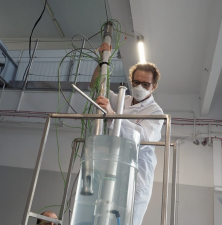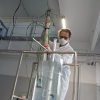High-temperature irradiation rig started its operation in the MARIA reactor core
2021.08.31 16:11 - Marek PawłowskiSince 27th of August, 2021 irradiation rig has been successfully operating in the core of MARIA reactor. This installation allows irradiation of material samples at temperature of 1000°C, that’s under conditions prevailing in HTGR reactors. The device was built at Polish National Centre for Nuclear Research (NCBJ) as part of the GoHTR project.
The ISHTAR (name derived from Irradiation System for High-Temperature Reactors) irradiation rig, designed and built at the Nuclear Facilities Operation Department, enables irradiation of material samples in MARIA reactor under conditions prevailing in high-temperature gas reactors, i.e. temperature up to 1000°C and in helium atmosphere. This level of temperature inside the rig is ensured through simultaneous gamma radiation and electric heating, and thermal insulation of gas gap. Conducted tests of samples placed in the rig are to determine the effect of radiation field and high temperature on the strength and structure of materials intended for use in the construction of new reactors, particularly of core elements.
“Launch of the ISHTAR high-temperature rig and achieving operating temperature of 1000°C took place after MARIA reactor entered its target power – nominal for a given operating cycle” – explains Marek Migdal MSc., one of the designers of the device. “We are currently testing graphite samples from which many elements of the core will be made. The device will operate in core for about one month. The neutron flux in MARIA research reactor is several orders of magnitude higher than in NPP. Thanks to this, the possible effects of damage and changes in the structure of tested samples observed after a month will correspond to the effects that would arise under normal circumstances only after several years of operation.”
After the irradiation cycle in MARIA reactor, samples will be transported to NCBJ’s Material Research Laboratory, where appropriate tests will be carried out. Samples subjected to strong radiation will be active due to nuclear changes caused by bombarding with neutrons. Therefore, both transport and subsequent tests will be carried out under special conditions.
The ISHTAR rig was designed and constructed at NCBJ as part of the GoHTR project - „Preparation of legal, organizational and technical instruments for the implementation of HTR reactors”. The project with the participation of the Polish Ministry of Climate and Environment, NCBJ and the Institute of Nuclear Chemistry and Technology is implemented under the Strategic Programme for Scientific Research and Development – GOSPOSTRATEG co-financed by the National Centre for Research and Development.
HTGR (High-Temperature Gas Reactors) are considered worldwide as one of the promising options among various new generation reactor technologies. They can produce heat at a temperature sufficient for use in the chemical industry, e.g. for the production of hydrogen by high-temperature water splitting. Research on this technology is currently carried out, among others, by Japan and China. Appropriate competences are also built at NCBJ.


















